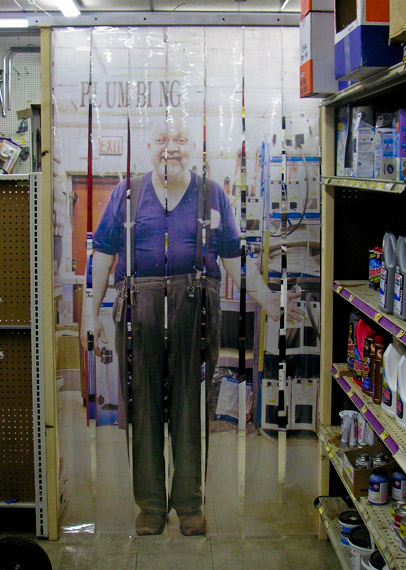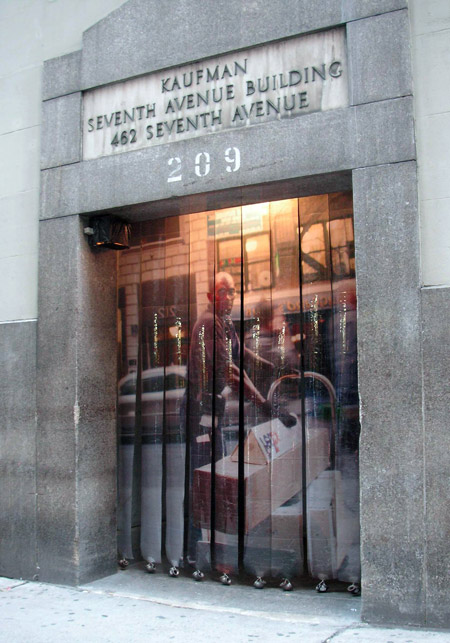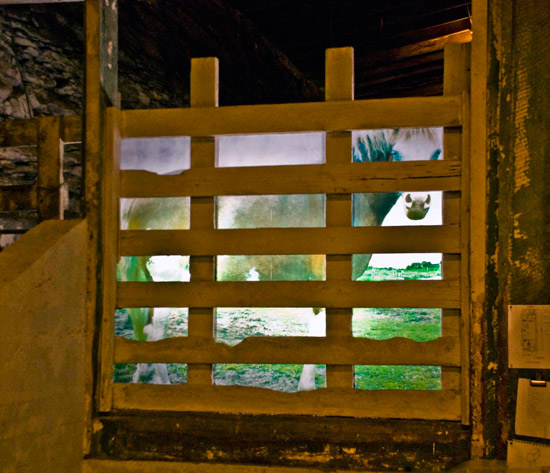Ryan Frank’s work borrows from objects that we normally take for granted. Mailboxes, wooden fences, cinder blocks, shipping pallets, and, this one is my favorite, industrial PVC strip curtains. If you have seen Ryan’s photo curtains, you would probably never look at these industrial plastic strips the same way again. Last month, I was invited to do studio visits at the Wassaic Project, and although I completely missed my last appointment, which was Ryan’s, his work definitely caught my attention. At the recent opening of “What is the Where” a group exhibition at the Invisible Dog, I had a chat with the artist standing next to his latest pieces – stage-like mailboxes and a door.
When did you start to make the curtain pieces?
I started making the curtain pieces in 2006, the first of which was for an outdoor installation in midtown Manhattan as part of the Fashion Center Arts Festival. I was asked to do an installation in a building loading dock, and at the time was just starting to experiment with different methods of displaying photographs in non-traditional materials. The plastic sheeting that hangs in loading docks and commercial refrigerators and freezers had a certain minimalist beauty to it and fit so well into the space I was using. I ended up using an image I shot of a FedEx deliveryman at the exact location where the piece was installed. And the materials I use to make these pieces are actually quite simple – inkjet prints on full sheet adhesive transparencies printed out in sections in Photoshop. Since then I’ve probably made 7 or 8 additional curtain pieces all in different locations. They’re very adaptable to different types of spaces and always respond to the setting in which they are placed.
All of your subjects seems to be caught in the moment. I’m especially intrigued by the “Factory Worker Curtain” (installation for the Artkraft-Strauss Building) Is there a story behind it?
My old studio was in the ArtKraft Strauss building on 57th Street, which was a sign factory that made billboards and theater marquis for many many years. The building had such history and while most of it had been cleaned up to convert into studios, there was a small area of the space, which was left unchanged. It was a perfect setting to install a piece and a doorway made an ideal frame for a photo curtain like the ones I had done before. I looked in the NY Public Library picture collection for images of factory workers and came across a shot that dated roughly from the same time that the building first opened. The figure in the image had such dignity and also a certain humility. With this in mind I created a piece that consisted of three different elements: an audible “factory” soundtrack that played continuously, a re-creation of the image on a curtain, and on the other side of the curtain a tangible hat that looked identical to the one seen in the photograph. Together these elements created a monument to the unknown and forgotten laborers who worked in the building before I did. Over the course of making the curtain pieces I’ve become fascinated with the physical identity of the worker in its various forms, and also how the role of the artist as a maker and producer fits within that construct.
You must be constantly observing the passerby, since they essentially become your subjects. What aspects about them interest you most?
I photograph almost all my subjects on the street and while I rarely talk with them, I think there’s an interesting challenge in trying to capture the essence of someone by how they present themselves physically. Clothes play a part of this, but also the things that they carry (their props) and most importantly how they stand and shape their body when going about their normal routine and not formally posing for a photograph. In a previous series of work I photographed public statues throughout New York City and was interested in how these monuments remained the only constant in an ever-changing city. Over the course of working on this series I created an archive of several thousand images of people on the street juxtaposed with the statues in the background, which I have since used as source material for several sculptural works.
Can you tell me more about the latest mailbox piece that’s part of the “What is Where” Recession Art Show?
I first started to use the mailbox as a frame to exhibit photographs during my residency at the Wassaic Project this past summer. In the area around Wassaic there are these rustic looking mailboxes scattered along the road, and I thought the form of the mailbox was an interesting object to work with. When I was younger, mail was something that excited me, it’s a type of gift that comes to you, and the form of the mailbox itself mimics that of a stage with a door that swings open to reveal something unexpected. At the same time, physical mail is now something that is in decline and far less important than it once was due to technology. The first mailbox piece used a layering of different images — the foreground image of a person talking on a cell phone was taken in lower Manhattan, the background was the suburban street that I grew up on, and it was placed within a rural style mailbox. Together these elements spoke to my experiences in urban, suburban, and rural settings. I continued this theme with the ‘Apartment Mailbox’ for the Recession Art show, which is a multi-unit mailbox typical in a Brooklyn apartment building and paired with a doorframe that also displays an image. Installed together I wanted these two works to give viewers the allusion of a going through an apartment entryway, and re-examine these utilitarian objects they interact with on a daily basis.
The scenic backgrounds that are juxtaposed behind the characters, which are also labeled on the mailboxes, seem to be a sort of commentary on city versus nature. Was that your intention?
The backgrounds are all different landscapes of places I have traveled — a beach and mountain in Antigua, an Alaskan glacier, and a grassy field Upstate. The figures in the foreground are from images I took on the street in the city and I choose four distinct figures each paired with a landscape background that captured their mood and put them in an appropriate psychological setting (i.e. a swaggering well-dressed businessman is placed on a beach and a disheveled figure appears on a cliff). These combinations reveal something about the figures in the image and also, when placed within a mailbox, demonstrate how information has different contexts in different settings.
You’re also a curator, any upcoming projects?
I recently curated a show titled ‘Used Books’ at the Winkleman Gallery Curatorial Reseach Lab, which combined works of art with books the artist felt had an impact on their creation. The project was developed over two years and I’d love to expand the show in a larger venue sometime in the future. I’m also developing a concept for a show that would re-create a domestic space made entirely out of art objects. Individual artists have done similar installations on their own but I’d love to show various artists together who all use domestic spaces as a source of inspiration.
What do you listen to for inspiration?
I sometimes listen to music, typically Pandora so I don’t have to think about what to play, but I usually prefer listening to talk radio or NPR. The sound of people talking is something I’ve always found comforting while working in the studio, and something can always be learned by listening to news and information, whether it be constructive or just plain ridiculous.
(all images courtesy of the artist)
website: ryanfrank.com







 RSS
RSS
